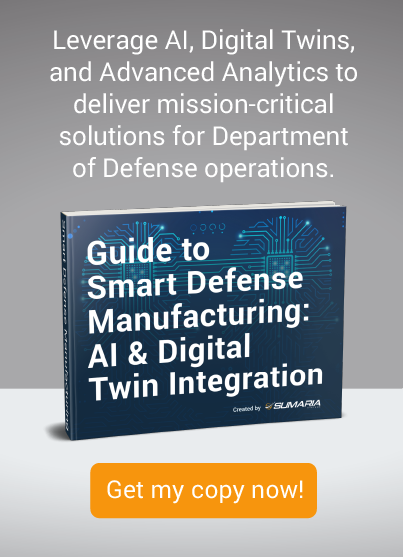
7 Ways That AI Implementation and Analytics Improve DoD Decision-Making
Military leaders today face an overwhelming flow of information, including sensor feeds, cyber data, satellite imagery, logistics reports, and ground assessments. With speed being of utmost importance, especially in field operations, most traditional processes simply can’t keep up with the sheer volume, velocity, and variety of the data required to make mission-critical choices.
The Department of Defense (DoD) is leaning into artificial intelligence (AI) and advanced analytics. Across the federal government, more than 2,000 AI use cases are already active across forty-one agencies, with defense applications among the most advanced. AI is transforming decision-making at every level, from real-time battlefield tactics to long-term resource planning.
In fact, the Pentagon recently staged AI-enhanced dogfights, where the Air Force’s autonomous VISTA fighter jet competed against a manned F-16. These experiments show how rapidly AI is becoming embedded in military operations.
Let’s take a closer look at the specifics. Here are seven ways that AI implementation and analytics are being deployed to augment human decision-making.
1. Turning Data Overload Into Actionable Intelligence
DoD systems collect petabytes of data daily from satellites, drones, radar, and cyber monitoring tools. Human analysts, no matter how skilled, cannot realistically parse everything in time to support tactical or strategic decisions.
AI analytics address this challenge by prioritizing signals over noise. Machine-learning models detect anomalies, flag unusual behaviors, and surface critical insights that human teams can act on. For example:
- Intelligence, surveillance, and reconnaissance platforms powered by AI provide commanders with faster, sharper situational awareness.
- On the battlefield, AI integrates multi-domain feeds into a unified picture, cutting through clutter so leaders can focus on what matters most.
Therefore, analysts spend less time combing through raw data and more time applying judgment to produce insights.
2. Improving Strategic Forecasting and Scenario Planning
Defense planning has always involved predicting adversary behavior and anticipating future conflicts. But predictive analytics now models scenarios with greater precision than ever.
AI enhances the OODA loop (observe, orient, decide, act) by improving how leaders test future outcomes. Models can simulate adversary maneuvers, forecast supply needs, and identify logistics bottlenecks before they occur. For example:
- Predictive models help anticipate supplier bankruptcies, preventing sudden breakdowns in defense supply chains.
- War-gaming simulations enable commanders to rehearse multiple scenarios, reducing uncertainty and expanding options.
All of this helps military leaders be more proactive and make better decisions.
3. Enabling Real-Time Operational Decision Support
On the ground, in the air, and across command centers, AI now delivers recommendations in seconds. Analytics platforms fuse live data from satellites, drones, cyber sensors, and human reports, then suggest optimal actions. Commanders can reallocate resources or adjust tactics instantly, guided by machine-generated insights. Examples include:
- Reallocating air assets mid-mission in response to shifting threats like small drones and other threats
- Integrating cross-domain information (land, air, cyber, and space) for battlefield awareness and reliability
By reducing delays in analysis, AI provides leaders with the insight that they need to make critical, time-sensitive decisions.
4. Optimizing Resource Allocation and Budget Efficiency
Military budgets may be big but they are not unlimited. Every dollar, piece of equipment, and human resource must be deployed where it matters most.
AI empowers leaders to cut waste by revealing underutilized assets or redundant spending. By tracking where funds are allocated in near real time, you can optimize resources and direct investments toward the most mission-critical areas.
AI is being used currently for:
- AI-enabled supply chain optimization, highlighting risks and prioritizing suppliers most critical to operations
- Route planning in contested environments, where algorithms find safe and efficient paths for logistics despite adversary actions
Here, AI reduces costs and helps ensure the strategic alignment between resources and mission priorities.
5. Strengthening Mission Readiness and Reliability
No matter how advanced a system is, it must function reliably when called upon. Predictive maintenance, powered by AI, helps ensure just that. Machine-learning models analyze sensor data from aircraft, vehicles, and weapons to predict failures before they occur. This prevents unscheduled breakdowns and reduces downtime using advanced analytics that support every phase of operations.
Two recent case studies on mission readiness showed significant results:
- The US Army raised average system uptime from 85% to 95%, dramatically improving mission readiness.
- The Air Force reported that AI-enabled predictive maintenance on the B-1 bomber reduced maintenance hours by more than 50% while virtually eliminating unscheduled repairs.
For mission leaders, this translates directly into higher readiness and operational reliability.
6. Securing Decision-Making Against Cyber and Information Threats
Data itself has now become a battlefield. Adversaries are active in their efforts to corrupt, overload, or manipulate information streams.
AI-driven cybersecurity counters these efforts by:
- Monitoring for anomalies across networks in real time
- Detecting intrusion attempts and shutting down attacks before they spread
- Identifying and countering disinformation campaigns targeting decision-makers
The insights that you get from any system are only as good as the integrity of the data. AI helps protect your data from corruption, making sure commanders can act on trustworthy information. Without that assurance, even the most advanced analytics can be rendered unusable.
Throughout the DoD, enhanced cybersecurity is helping manage data streams.
7. Supporting Human-Machine Interactions for Better Outcomes
AI in defense is not about replacing commanders. It’s about augmenting human decision-making. Adaptive systems act as copilots, tactical advisors, and strategic assistants to help reduce the cognitive burden on leaders who must make rapid decisions under stress. Examples include:
- AI copilots that recommend flight adjustments during missions and may lead to autonomous delivery
- Tactical assistants that highlight the best available course of action while leaving the final choice to human judgment
As retired Army Gen. Paul Nakasone stressed, “We do see assistance from artificial intelligence. But at the end of the day, decisions will be made by humans and humans in the loop.” A balanced approach is crucial for enhancing decision quality while maintaining accountability and ethical oversight.
Barriers to AI Implementation in Defense Programs
Despite its promise, AI adoption in defense faces significant hurdles:
- Legacy infrastructure that often cannot support advanced data analytics
- Cultural resistance from personnel wary of relying on machines
- Fragmented data environments that make integration difficult
- Oversight concerns about autonomy and decision transparency
Order 14179, “Removing Barriers to American Leadership in Artificial Intelligence,” calls for overcoming these challenges through:
- Phased rollouts and pilot programs
- Stronger cross-branch collaboration
- Transparent governance structures
It will take a coordinated effort within DoD and collaboration with outside organizations that have the experience and understanding of DoD systems.
A Strategic Imperative: Why DoD Leaders Must Act Now
AI is already delivering measurable results across the DoD. However, other nations are also investing heavily in AI-driven defense decision-making, and waiting risks leaving US forces at a disadvantage.
Early adopters gain a lasting strategic advantage, as AI systems continuously learn and improve. Leaders who move now will secure an edge in tomorrow’s battlespace, while those who hesitate may find themselves struggling to catch up.
Digital twins and AI bring real-time foresight and control into defense manufacturing. Whether building new systems or sustaining legacy platforms, these technologies empower DoD leaders to reduce cost, mitigate risk, and ensure production resilience at scale. Contact us for help with the strategic integration of advanced technologies and methods to streamline and optimize the development, maintenance, and operation of systems and infrastructures.

